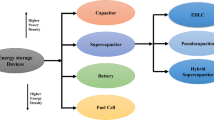Abstract
This work describes optimized conditions for the use of cellulose acetate (CA), a naturally derived polymer, in gel electrolytes (GEs) for electrochromic devices (ECDs). The GEs were doped with lithium perchlorate (LiClO4) as a supporting salt electrolyte and propylene carbonate as a solvent. The conductivity of GEs with varying CA concentration was evaluated by a conductivity meter to determine the effectiveness of electrolyte ion transport in the GE matrix. Then, we employed poly(3-hexylthiophene-2,5-diyl) (P3HT) thin films as an electrochromic layer on an ITO substrate. The P3HT film served as the main cathodic electrochromic layer, the GE as an ion conducting layer, and a piece of bare ITO substrate as an anodic electrochromic layer. We evaluated the stability of the P3HT film by measuring the optical and electrochemical properties of P3HT thin films on ITO in GEs through UV–Vis and cyclic voltammograms obtained during application of potential to the films. Current/voltage data and related performance for ECDs were investigated. The results showed that the prepared GEs have high stability within the operative potential window for ECDs. The electrochromic polymer films operated with the prepared GE showed good stability with fully reversible color change for more than 1000 cycles without polymer film or GE degradation. This work shows the first example of the use of GE with a natural polymer matrix in electrochromic devices and demonstrates their reliability under repetitive switching of applied voltage for up to 1000 cycles.
Graphical Abstract











Similar content being viewed by others
References
Lin S-Y, Chen Y-C, Wang C-M, Wen C-Y, Shih T-Y (2012) Study of MoO3–NiO complementary electrochromic devices using a gel polymer electrolyte. Solid State Ion 212:81–87
Kiristi M, Bozduman F, Gulec A, Teke E, Oksuz L, Oksuz UA, Deligöz H (2014) Complementary all solid state electrochromic devices using carboxymethyl cellulose based electrolytes. J. Macromol Sci 51:481–487
Ramos MA, Pereira S, Ciade MT, Pereira G, Branquinho R, Pereira L, Martins R, Fortunato E (2013) Preparation and characterization of cellulose nanocomposite hydrogels as functional electrolytes. Solid State Ion 242:26–32
Ledwon P, Andrade RJ, Lapkowski M, Pawlicka A (2015) Hydroxypropyl cellulose-based gel electrolyte for electrochromic devices. Electrochim Acta 159:227–233
Thakur KV, Ding G, Ma J, Lee SP, Lu X (2012) Hybrid materials and polymer electrolytes for electrochromic device applications. Adv Mater 24:4071–4096
Deepa M, Sharma N, Agnihotry AS, Singh S, Lal T, Chandra R (2002) Conductivity and viscosity of liquid and gel electrolyte based on LiClO4, LiN(CF3SO2)2 and PMMA. Solid State Ion 152–153:253–258
Reiter J, Krejza O, Sedlarikova M (2009) Electrochromic devices employing metharcrylate-based polymer electrolytes. Sol Energy Mater Sol Cells 93:249–255
Barbosa CP, Silva MM, Smith JM, Goncalves AG, Fortunato E (2007) Studies of solid-state electrochromic devices based on PEO/siliceous hybrids doped with lithium perchlorate. Electrochim Acta 52:2938–2943
Ramesh S, Shanti R, Morris E (2013) Characterization of conducting cellulose acetate based polymer electrolytes doped with “green” ionic mixture. Carbohydr Polym 91:14–21
Abidin ZZZS, Ali MMA, Hassan HO, Yahya AZM (2013) Electrochemical studies on cellulose acetate–LiBOB polymer gel electrolytes. Int J Electrochem Sci 8:7320–7326
Singh B, Kumar R, Sekhon SS (2005) Conductivity and viscosity behavior of PMMA based gels and nano dispersed gels: role of dielectric constant of solvent. Solid State Ion 176:1577–1583
Sekhon SS, Arora N, Singh PH (2003) Effect of donor number of solvent on the conductivity behavior of nonaqueous proton-conducting polymer gel electrolytes. Solid State Ion 160:301–307
Seo MD, Reininger S, Kutcher M, Redmond K, Euler BW, Lucht LB (2015) Role of mixed solvations and ion pairing in the solution structure of lithium ion battery electrolytes. J Phys Chem C 119:14038–14046
Holt LA, Wehner AGJ, Hammp A, Morse ED (2010) Plastic transmissive infrared electrochromic devices. Macromol Chem Phys 211:1701–1707
Huang J-H, Yang C-Y, Hsu C-Y, Chen C-L, Lin L-Y, Wang R-R, Ho K-C, Chu C-W (2009) Solvent-annealing-induced self-organization of poly(3-hexylthiophene), a high-performance electrochromic material. ACS Appl Mater Interfaces 1:2821–2828
Kirillov SA, Gorobets MI, Tretyakov DO, Ataev BM, Gafurov MM (2015) Phase diagrams and conductivity of lithium salt systems in dimethyl sulfoxide, propylene carbonate and dimethyl carbonate. J Mol Liq 205:78–84
Kuratani K, Uemura N, Senoh H, Takeshita TH, Kiyobayashi T (2013) Conductivity, viscosity and density of MClO4 (M=Li and Na) dissolved in propylene carbonate and γ-butyrolactone at high concentrations. J Power Sources 223:175–182
Kim SC, Oh MS (2001) Performance of gel-type polymer electrolytes according to the affinity between polymer matrix and plasticizing solvent molecules. Electrochim Acta 46:1323–1331
Pomerantz Z, Zaban A, Ghosh S, Lellouche J-P, Gracia-Belmonte G, Bisquert J (2007) Capacitance, spectroelectrochemistry and conductivity of polarons and bipolarons in a polydicarbazole based conducting polymer. J Electroanal Chem 614:49–60
Acknowledgments
This work was supported by the National Nanotechnology Center, NSTDA, Thailand. The authors would like to thank Dr. Daniel P. Sweat, Dr. Rawiwan Laocharoensuk, Dr. Pisist Kumnorkaew and Mr. Thanakorn Jiemsakul for fruitful discussions.
Author information
Authors and Affiliations
Corresponding author
Rights and permissions
About this article
Cite this article
Ngamaroonchote, A., Chotsuwan, C. Performance and reliability of cellulose acetate-based gel electrolyte for electrochromic devices. J Appl Electrochem 46, 575–582 (2016). https://doi.org/10.1007/s10800-016-0918-4
Received:
Accepted:
Published:
Issue Date:
DOI: https://doi.org/10.1007/s10800-016-0918-4




